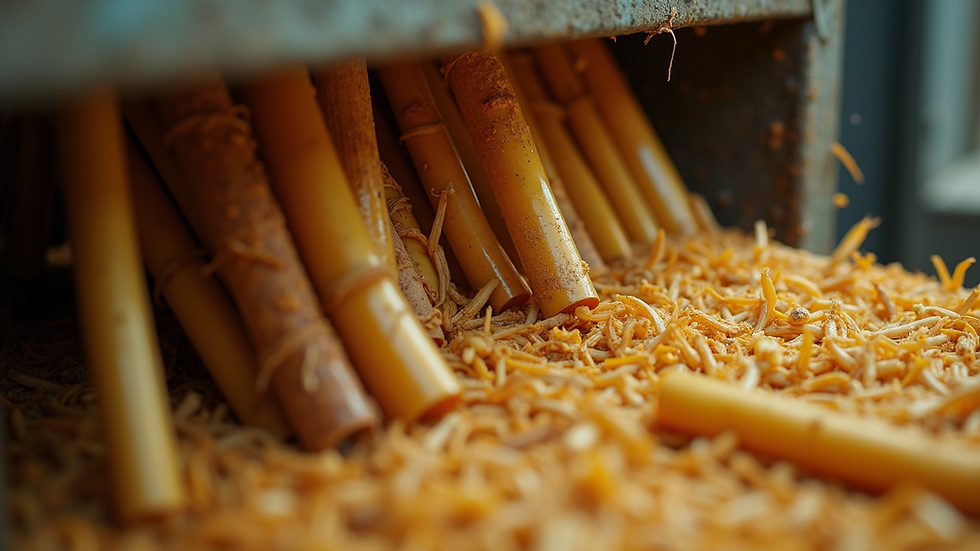Inside the Sugar Production Process
- writer
- 2 days ago
- 3 min read
Sugar is a vital ingredient in many products worldwide. Understanding the steps in sugar production helps buyers and brands make informed decisions. The process transforms raw materials into the refined sugar used in food and beverages. I will walk you through the main stages of sugar production. This knowledge is essential for those who want to source high-quality sugar reliably.
The Main Steps in Sugar Production
The sugar production process starts with harvesting sugarcane or sugar beets. These plants contain sucrose, the sugar we use daily. The first step is to extract the juice from the raw material. For sugarcane, this involves crushing the stalks in large mills. For sugar beets, the beets are sliced and soaked in hot water to release the sugar.
Next, the juice undergoes purification. This step removes impurities like soil, plant fibers, and other solids. Lime and heat are added to the juice to clarify it. The impurities settle at the bottom and are removed. The clear juice is then concentrated by boiling it under vacuum conditions. This process thickens the juice into syrup.
The syrup is then crystallized. It is cooled and seeded with sugar crystals to encourage sugar formation. The crystals grow as the syrup cools. After crystallization, the mixture of crystals and syrup, called massecuite, is spun in centrifuges. This separates the sugar crystals from the remaining liquid, known as molasses.
Finally, the raw sugar crystals are dried and packaged. Some sugar undergoes further refining to produce white sugar. This refining removes remaining molasses and color. The final product is pure, white sugar ready for industrial use.

Detailed Steps in Sugar Production
Let me explain the steps in sugar production in more detail. First, harvesting is done either manually or with machines. Timing is crucial to maximize sugar content. After harvesting, the raw material is quickly transported to the mill to prevent sugar loss.
In the extraction phase, mills use heavy rollers to crush sugarcane. This mechanical pressing extracts juice efficiently. For sugar beets, slicing and diffusion with hot water extract the sugar. The juice contains impurities that must be removed.
Purification uses lime and heat to clarify the juice. The lime raises the pH, causing impurities to coagulate. These solids are filtered out. The clear juice is then evaporated in multiple stages to concentrate it. This step requires careful temperature control to avoid caramelization.
Crystallization is a controlled cooling process. The syrup is seeded with fine sugar crystals. These crystals act as nuclei for sugar to form. The massecuite is then spun in centrifuges to separate crystals from molasses. The molasses can be used for other products or further processed.
Refining involves dissolving raw sugar and filtering it through activated carbon or bone char. This removes color and impurities. The sugar is then recrystallized and dried. The result is pure white sugar suitable for food manufacturing.

Is Sugar Refined with Animal Bones?
A common question is whether sugar is refined with animal bones. Some sugar refining processes use bone char, which is made from animal bones, to filter and whiten sugar. This method is traditional and still used in some countries.
However, many sugar producers now use alternative methods. These include activated carbon and ion-exchange resins. These options avoid animal products and meet vegan and vegetarian standards. It is important to check with suppliers about their refining methods.
For industrial buyers, knowing the refining process is crucial. It affects product labeling and consumer acceptance. Brazilian sugar exporters often use modern refining techniques that do not involve bone char. This ensures the sugar meets diverse market requirements.

Quality Control and Packaging
Quality control is a key part of the sugar production process. Samples are tested at various stages to ensure purity, moisture content, and crystal size. Consistent quality is essential for industrial applications.
Packaging is designed to protect sugar during transport and storage. Bulk sugar is often packed in large bags or containers. Proper packaging prevents contamination and moisture absorption. Reliable supply chains ensure timely delivery to buyers worldwide.
Brazilian sugar exporters focus on maintaining high standards. They connect international buyers directly with mills. This reduces costs and improves supply reliability. Competitive pricing and consistent quality help build long-term partnerships.
Why Understanding the Sugar Production Process Matters
Understanding the sugar production process helps buyers make better choices. It clarifies how sugar quality is achieved. It also highlights the importance of sourcing from reputable producers.
For large brands and industrial buyers, this knowledge supports supply chain decisions. It ensures the sugar meets product specifications and consumer expectations. Working with trusted suppliers like Brazilian sugar exporters guarantees access to high-quality sugar.
In summary, the steps in sugar production are clear and well-established. From harvesting to refining, each stage affects the final product. Knowing these steps helps buyers secure the best sugar for their needs. It also supports sustainable and ethical sourcing practices.



Comments